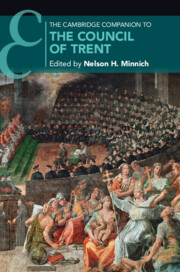Book contents
- The Cambridge Companion to the Council of Trent
- Frontispiece
- Cambridge Companions to Religion
- The Cambridge Companion to the Council of Trent
- Copyright page
- Contents
- Figures
- Contributors
- Acknowledgments
- Abbreviations
- 1 Introduction
- 2 The Organizational Structure of the Council of Trent
- 3 Schools of Theology at the Council of Trent
- 4 Scripture and Traditions at the Council of Trent
- 5 Original Sin and Justification
- 6 Sacraments in General, Baptism and Confirmation
- 7 The Sacrament of Penance at the Council
- 8 Presence and Sacrifice
- 9 Bishops
- 10 The Tridentine Proposal for the Formation of the Clergy
- 11 Pastoral Care
- 12 The Decree on Marriage
- 13 Reform of the Religious Orders
- 14 Sacred Art
- 15 Sacred Music
- 16 The Papacy and the Application of Conciliar Decrees
- Index
- Cambridge Companions to Religion (continued from page iii)
- References
3 - Schools of Theology at the Council of Trent
Published online by Cambridge University Press: 02 October 2023
- The Cambridge Companion to the Council of Trent
- Frontispiece
- Cambridge Companions to Religion
- The Cambridge Companion to the Council of Trent
- Copyright page
- Contents
- Figures
- Contributors
- Acknowledgments
- Abbreviations
- 1 Introduction
- 2 The Organizational Structure of the Council of Trent
- 3 Schools of Theology at the Council of Trent
- 4 Scripture and Traditions at the Council of Trent
- 5 Original Sin and Justification
- 6 Sacraments in General, Baptism and Confirmation
- 7 The Sacrament of Penance at the Council
- 8 Presence and Sacrifice
- 9 Bishops
- 10 The Tridentine Proposal for the Formation of the Clergy
- 11 Pastoral Care
- 12 The Decree on Marriage
- 13 Reform of the Religious Orders
- 14 Sacred Art
- 15 Sacred Music
- 16 The Papacy and the Application of Conciliar Decrees
- Index
- Cambridge Companions to Religion (continued from page iii)
- References
Summary
Most of the schools of theology present at the Council of Trent arose after the middle of the thirteenth century and late medieval theology attributed a certain theological authority to these schools. This chapter examines the way in which these schools contributed positively to the development of the council’s doctrinal decrees where there was consensus among them. While the council fathers generally avoided favoring one Catholic school of theology over another, there were occasions when the view of a particular school was rejected. This chapter also examines some of the various schools at Trent, such as Scotism and Thomism, and their prominent members.
- Type
- Chapter
- Information
- The Cambridge Companion to the Council of Trent , pp. 53 - 71Publisher: Cambridge University PressPrint publication year: 2023



